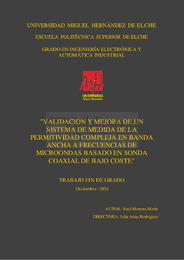Please use this identifier to cite or link to this item:
https://hdl.handle.net/11000/36045Validación y mejora de un sistema de medida de la permitividad compleja en banda ancha a frecuencias de microondas basado en sonda coaxial de bajo coste
| Title: Validación y mejora de un sistema de medida de la permitividad compleja en banda ancha a frecuencias de microondas basado en sonda coaxial de bajo coste |
| Authors: Moreno Merín, Raúl |
| Tutor: Arias, Julia |
| Editor: Universidad Miguel Hernández de Elche |
| Department: Departamentos de la UMH::Ingeniería de Sistemas y Automática |
| Issue Date: 2024-12 |
| URI: https://hdl.handle.net/11000/36045 |
| Abstract: Este trabajo de fin de grado (TFG) aborda el diseño, validación y mejora de un sistema económico para la medida de la permitividad compleja de diferentes materiales. Este sistema utiliza una sonda coaxial con conector SMA, de bajo coste, y un analizador de redes vectorial (VNA) controlado por una aplicación desarrollada en Python. El trabajo se centra en caracterizar líquidos de referencia, soluciones salinas y tejidos biológicos, seleccionados por su relevancia en aplicaciones biomédicas, industriales y de telecomunicaciones, en los que la medida de la permitividad compleja tiene relevancia práctica. Esta propiedad describe la interacción de los materiales con campos eléctricos a diferentes frecuencias, considerando su capacidad de almacenamiento energético (parte real) y las pérdidas disipadas en forma de calor (parte imaginaria). La validación del sistema se llevó a cabo mediante la comparación de medidas experimentales con valores teóricos y resultados obtenidos con una sonda comercial de Keysight, reconocida como estándar en los ámbitos científico e industrial. La sonda SMA fue sometida a calibración y pruebas con diversos modelos teóricos (como el modelo capacitivo, de radiación y de línea virtual) para interpretar los datos y mejorar la precisión de las medidas. Los resultados demostraron que la sonda SMA, a pesar de ser una solución de bajo coste, logra una precisión aceptable para los materiales analizados en el rango de 10 MHz a 10 GHz, lo que ofrece una alternativa accesible frente a equipos comerciales costosos para su uso en contextos preliminares, abriendo además nuevas posibilidades para laboratorios con recursos limitados. Entre las aportaciones clave del proyecto, destaca la migración del software a una versión más avanzada de Python, permitiendo una implementación de una interfaz gráfica más intuitiva, que automatiza el control del VNA y el procesamiento de datos. Finalmente, el trabajo concluye con propuestas para mejorar el sistema, como el diseño de sondas con mejores prestaciones en alta frecuencia y la consideración de otros modelos de procesamiento de datos. This final degree project addresses the design, validation, and improvement of a cost-effective system for measuring the complex permittivity of various materials. The system employs a low-cost coaxial probe with an SMA connector and a vector network analyzer (VNA) controlled by a Python-based application. The work focuses on characterizing reference polar liquids, saline solutions, and biological tissues, selected for their relevance in biomedical, industrial, and telecommunications applications, where the measurement of complex permittivity has practical significance. This property describes the interaction of materials with electric fields at different frequencies, considering their energy storage capacity (real part) and energy dissipated as heat (imaginary part). The system was validated by comparing experimental measurements with theoretical values and results obtained using a commercial Keysight probe, recognized as a standard in scientific and industrial fields. The SMA probe was calibrated and tested with various theoretical models (such as the capacitive, radiation, and virtual line models) to interpret data and improve measurement accuracy. Results demonstrated that the SMA probe, despite being a low-cost solution, achieves acceptable accuracy for the analyzed materials in the range of 10 MHz to 10 GHz. This provides an accessible alternative to expensive commercial equipment for preliminary applications, opening new possibilities for laboratories with limited resources. Key contributions of the project include upgrading the software to a more advanced Python version, enabling the implementation of a more intuitive graphical interface that automates VNA control and data processing. Finally, the work concludes with proposals to enhance the system, such as designing probes with higher frequency performance and considering other data processing models. |
| Keywords/Subjects: permitividad campo eléctrico mecanismos de polarización analizador vectorial de redes sonda con conector sma tejidos biológicos soluciones salinas líquidos de referencia |
| Knowledge area: CDU: Ciencias aplicadas: Ingeniería. Tecnología |
| Type of document: info:eu-repo/semantics/bachelorThesis |
| Access rights: info:eu-repo/semantics/openAccess Attribution-NonCommercial-NoDerivatives 4.0 Internacional |
| Appears in Collections: TFG-Ingeniería Electrónica y Automática Industrial |
.png)

